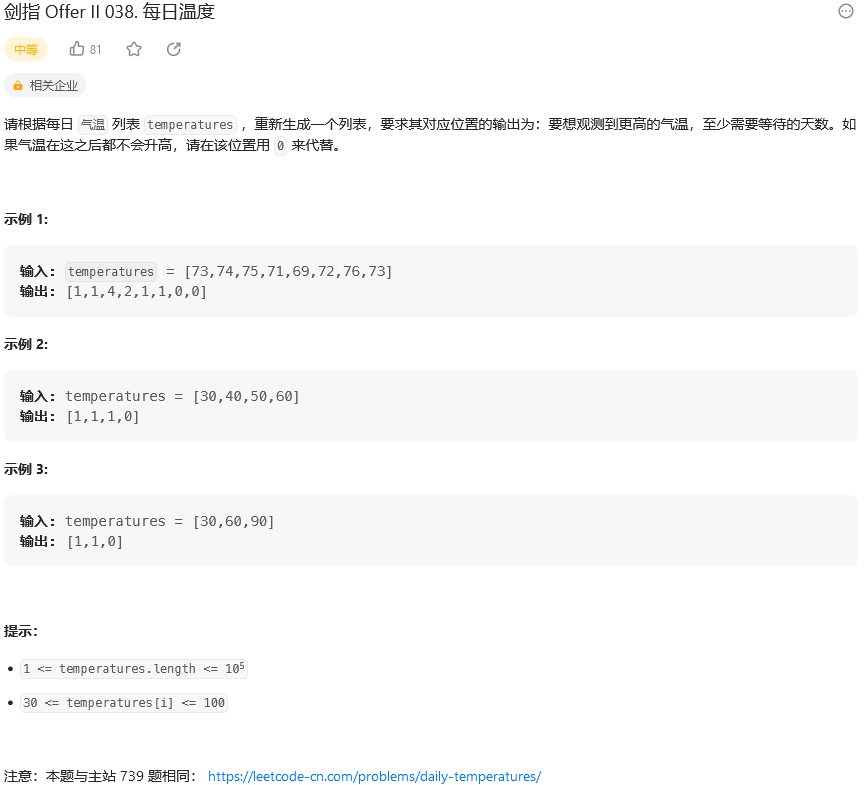剑指 Offer II 038. 每日温度(739. 每日温度)
题目:


思路:
【1】利用最大队列的思想(参考 面试题59 - II. 队列的最大值 )
【2】单调栈的思路(与上面利用队列最大值的思路差不多):
原理分析:
对于温度列表 [73,74,75,71,69,72,76,73],单调栈 stack 的初始状态为空,答案 ans 的初始状态是 [0,0,0,0,0,0,0,0],
按照以下步骤更新单调栈和答案,其中单调栈内的元素都是下标,括号内的数字表示下标在温度列表中对应的温度。
当 i=0 时,单调栈为空,因此将 0 进栈。
stack=[0(73)]
ans=[0,0,0,0,0,0,0,0]
当 i=1 时,由于 74 大于 73,因此移除栈顶元素 0,赋值 ans[0]:=1−0,将 1 进栈。
stack=[1(74)]
ans=[1,0,0,0,0,0,0,0]
当 i=2 时,由于 75 大于 74,因此移除栈顶元素 1,赋值 ans[1]:=2−1,将 2 进栈。
stack=[2(75)]
ans=[1,1,0,0,0,0,0,0]
当 i=3 时,由于 71 小于 75,因此将 3 进栈。
stack=[2(75),3(71)]
ans=[1,1,0,0,0,0,0,0]
当 i=4 时,由于 69 小于 71,因此将 4 进栈。
stack=[2(75),3(71),4(69)]
ans=[1,1,0,0,0,0,0,0]
当 i=5 时,由于 72 大于 69 和 71,因此依次移除栈顶元素 4 和 3,赋值 ans[4]:=5−4 和 ans[3]:=5−3,将 5 进栈。
stack=[2(75),5(72)]
ans=[1,1,0,2,1,0,0,0]
当 i=6 时,由于 76 大于 72 和 75,因此依次移除栈顶元素 5 和 2,赋值 ans[5]:=6−5 和 ans[2]:=6−2,将 6 进栈。
stack=[6(76)]
ans=[1,1,4,2,1,1,0,0]
当 i=7 时,由于 73 小于 76,因此将 7 进栈。
stack=[6(76),7(73)]
ans=[1,1,4,2,1,1,0,0]
【3】暴力的方式
由于温度范围在 [30, 100] 之内,因此可以维护一个数组 next 记录每个温度第一次出现的下标。
数组 next 中的元素初始化为无穷大,在遍历温度列表的过程中更新 next 的值。
反向遍历温度列表。对于每个元素 temperatures[i],
在数组 next 中找到从 temperatures[i] + 1 到 100 中每个温度第一次出现的下标,
将其中的最小下标记为 warmerIndex,则 warmerIndex 为下一次温度比当天高的下标。
如果 warmerIndex 不为无穷大,则 warmerIndex - i 即为下一次温度比当天高的等待天数,
最后令 next[temperatures[i]] = i。
代码展示:
暴力的方式:
//时间39 ms击败49.49% //内存55 MB击败38.49% //时间复杂度:O(nm),其中 n 是温度列表的长度,m 是数组 next 的长度,在本题中温度不超过 100,所以 m 的值为 100。反向遍历温度列表一遍,对于温度列表中的每个值,都要遍历数组 next 一遍。 //空间复杂度:O(m),其中 m 是数组 next 的长度。除了返回值以外,需要维护长度为 m 的数组 next 记录每个温度第一次出现的下标位置。 class Solution { public int[] dailyTemperatures(int[] temperatures) { int length = temperatures.length; int[] ans = new int[length]; int[] next = new int[101]; Arrays.fill(next, Integer.MAX_VALUE); for (int i = length - 1; i >= 0; --i) { int warmerIndex = Integer.MAX_VALUE; for (int t = temperatures[i] + 1; t <= 100; ++t) { if (next[t] < warmerIndex) { warmerIndex = next[t]; } } if (warmerIndex < Integer.MAX_VALUE) { ans[i] = warmerIndex - i; } next[temperatures[i]] = i; } return ans; } }
单调栈的思路:
//时间23 ms击败90.86% //内存56.9 MB击败36.1% //时间复杂度:O(n),其中 n 是温度列表的长度。 //正向遍历温度列表一遍,对于温度列表中的每个下标,最多有一次进栈和出栈的操作。 //空间复杂度:O(n),其中 n 是温度列表的长度。需要维护一个单调栈存储温度列表中的下标。 class Solution { public int[] dailyTemperatures(int[] temperatures) { int length = temperatures.length; int[] ans = new int[length]; Deque<Integer> stack = new LinkedList<Integer>(); for (int i = 0; i < length; i++) { int temperature = temperatures[i]; while (!stack.isEmpty() && temperature > temperatures[stack.peek()]) { int prevIndex = stack.pop(); ans[prevIndex] = i - prevIndex; } stack.push(i); } return ans; } }
利用最大队列的思想:
//时间38 ms击败45.58% //内存57.1 MB击败29.11% class Solution { public int[] dailyTemperatures(int[] temperatures) { //以{73,74,75,71,69,72,76,73}为例 int[] res = new int[temperatures.length]; LinkedList<Integer> queue = new LinkedList<>(); queue.addFirst(temperatures.length-1); for (int i = temperatures.length-2; i >= 0; i--){ int index = 0; //利用队列的特性,当现在为71时,此时队列内有【69,72,76】,因为69小所以下移到另一个 while (index < queue.size() && temperatures[i] >= temperatures[queue.get(index)]) index++; //这里保证了右边存在比当前数要大的才会记录,小的直接跳过 if (index < queue.size()) res[i] = queue.get(index) - i; //当现在为71时,此时队列内有【69,72,76】,因为71大于69,所以比71大的必然比69大,所以69用不到了应该移除 while (!queue.isEmpty() && temperatures[i] >= temperatures[queue.peekFirst()]) queue.pollFirst(); //添加后队列为【71,72,76】 queue.addFirst(i); } return res; } }

